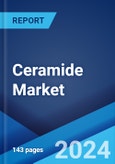The global ceramide market size was valued at USD 412.3 Million in 2024. Looking forward, the analyst estimates the market to reach USD 628.8 Million by 2033, exhibiting a CAGR of 4.56% during 2025-2033. Asia Pacific currently dominates the market, holding a significant market share of 37.3% in 2024. At present, Asia Pacific holds the largest ceramide market share owing to increasing awareness for skin health, robust manufacturing capabilities, supportive government initiatives, and favorable demographics.
Ceramides are lipids found naturally in cell membranes and composed of sphingosine alcohol with fatty acids. They aid in mediating various cellular processes affecting cell differentiation and apoptosis. As a result, they are utilized in liver steatosis, obesity-associated comorbidities, regulating inflammation, and oxidizing impaired fatty acid. Moreover, they are used as a moisturizing agent in various cosmetic and personal products to help treat different skin and hair problems caused by chronic dryness, environmental factors, aging, and skin damage.
Additionally, the emerging trend of vegan cosmetics is positively influencing the adoption of ceramides as they are synthetically produced without the use of animal byproducts. Besides this, as diabetes mellitus is one of the leading causes of death worldwide, there is a rise in the utilization of ceramides in the pharmaceutical industry. Furthermore, ceramides play a significant role in insulin resistance, induction of β-cell apoptosis, and the reduction of insulin gene expression, which assists in identifying potential therapeutic targets for managing diabetes mellitus and its complications. Apart from this, due to rising health consciousness among individuals, ceramides are widely being used in supplements that promote a healthier life.
Ceramides are lipids found naturally in cell membranes and composed of sphingosine alcohol with fatty acids. They aid in mediating various cellular processes affecting cell differentiation and apoptosis. As a result, they are utilized in liver steatosis, obesity-associated comorbidities, regulating inflammation, and oxidizing impaired fatty acid. Moreover, they are used as a moisturizing agent in various cosmetic and personal products to help treat different skin and hair problems caused by chronic dryness, environmental factors, aging, and skin damage.
Ceramide Market Trends:
Individuals who suffer from eczema and psoriasis have a significant reduction of ceramides in their skin. Thus, the rising prevalence of eczema and psoriasis on account of the increasing number of people that drink and smoke represents one of the key factors catalyzing the usage of ceramides in dermatological products. In line with this, as naturally occurring ceramides decline with age, the growing geriatric population is driving the demand for ceramide-based products to improve water retention, restore the skin’s natural barrier, and reduce the visible signs of aging.Additionally, the emerging trend of vegan cosmetics is positively influencing the adoption of ceramides as they are synthetically produced without the use of animal byproducts. Besides this, as diabetes mellitus is one of the leading causes of death worldwide, there is a rise in the utilization of ceramides in the pharmaceutical industry. Furthermore, ceramides play a significant role in insulin resistance, induction of β-cell apoptosis, and the reduction of insulin gene expression, which assists in identifying potential therapeutic targets for managing diabetes mellitus and its complications. Apart from this, due to rising health consciousness among individuals, ceramides are widely being used in supplements that promote a healthier life.
Key Market Segmentation:
This report provides an analysis of the key trends in each sub-segment of the global ceramide market report, along with forecasts at the global, regional and country level from 2025-2033. Our report has categorized the market based on type, process, and application.Breakup by Type:
- Natural
- Synthetic
Breakup by Process:
- Fermentation Ceramides
- Plant Extract Ceramides
Breakup by Application:
- Cosmetics
- Food
- Others
Breakup by Region:
- North America
- United States
- Canada
- Asia-Pacific
- China
- Japan
- India
- South Korea
- Australia
- Indonesia
- Others
- Europe
- Germany
- France
- United Kingdom
- Italy
- Spain
- Russia
- Others
- Latin America
- Brazil
- Mexico
- Others
- Middle East and Africa
Competitive Landscape:
The competitive landscape of the industry has also been examined along with the profiles of the key players being Air Liquide S.A., Anderson Global Group LLC, Arkema S.A., Ashland Inc., Cayman Chemical Company, Croda International Plc, Evonik Industries AG, Incospharm Corporation, Jarchem Industries Inc., Kao Corporation, Toyobo Co. Ltd. and Vantage Specialty Chemicals.Key Questions Answered in This Report:
- How big is the ceramide market?
- What is the future outlook of the ceramide market?
- What are the key factors driving the ceramide market?
- Which region accounts for the largest ceramide market share?
- Which are the leading companies in the global ceramide market?
Table of Contents
1 Preface3 Executive Summary11 Value Chain Analysis13 Price Analysis
2 Scope and Methodology
4 Introduction
5 Global Ceramide Market
6 Market Breakup by Type
7 Market Breakup by Process
8 Market Breakup by Application
9 Market Breakup by Region
10 SWOT Analysis
12 Porters Five Forces Analysis
14 Competitive Landscape
List of Figures
List of Tables
Companies Mentioned
- Air Liquide S.A.
- Anderson Global Group LLC
- Arkema S.A.
- Ashland Inc.
- Cayman Chemical Company
- Croda International Plc
- Evonik Industries AG
- Incospharm Corporation
- Jarchem Industries Inc.
- Kao Corporation
- Toyobo Co. Ltd.
- Vantage Specialty Chemicals
Methodology

LOADING...
Table Information
| Report Attribute | Details |
|---|---|
| No. of Pages | 142 |
| Published | April 2025 |
| Forecast Period | 2024 - 2033 |
| Estimated Market Value ( USD | $ 412.3 Million |
| Forecasted Market Value ( USD | $ 628.8 Million |
| Compound Annual Growth Rate | 4.8% |
| Regions Covered | Global |
| No. of Companies Mentioned | 12 |









